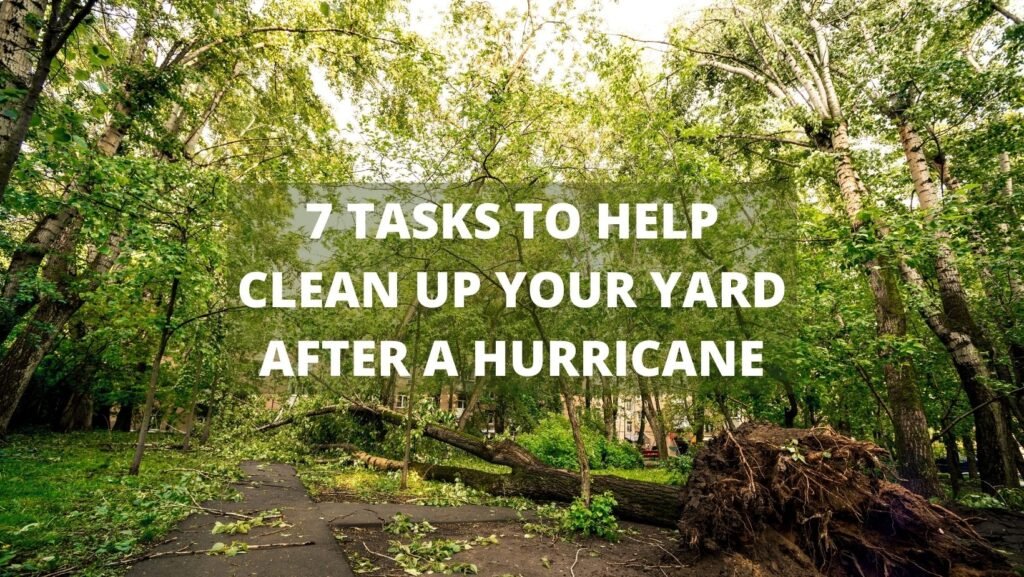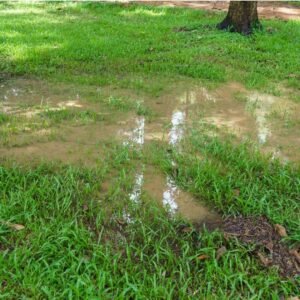Hurricanes are a way of life for those of us here in Northern Florida. Back in August, we put together a helpful guide on how to prepare your lawn for a hurricane. Today, we’re looking at how to clean up after a hurricane. Because we know that post-hurricane lawn care is no fun, we put together this list of 7 tasks to help make your job easier.
First, inspect all trees on your property
Lawn care after a hurricane starts with an inspection. While obvious damage to your home or physical structures should be left to the contracting professionals, there are several things you can do to help your yard after a hurricane. And that starts with an inspection of all trees on your property.
Trees are the primary cause of post-hurricane damage. High winds do their fair share during the storm but weakening trees can have adverse effects later. If there is significant damage to any of your trees, you’ll want to make note of them and contact a tree removal or trimming company that can take care of the broken branches.
Next, pick up small twigs, leaves, and debris
As you clean up after a hurricane, you’re going to encounter smaller types of debris such as twigs, leaves, and even trash from your neighborhood strewn across your yard. Before you or your landscaping company mows the grass again, you’ll need to clean all of these up.
It may be tempting to leave them — after all, the mower blades can just chop them up, right? Wrong. In fact, smaller debris can shoot out of your mower, turning into make-shift bullets. The last thing you want to do is damage your or your neighbor’s house after getting it fixed back up. So, take a yard rake and scoop up all of this smaller debris.
Then, clean up smaller to medium-sized branches
It’s inevitable, about as much as Thanos if we’re being honest, that you’re going to have larger branches scattered across your yard. Those larger branches — bigger than twigs mind you — will make lawn care after a hurricane difficult. Cleaning them up by collecting them and stacking them in a pile may take a lot of work, but it’ll be worth it in the end. In addition, smaller branches again may seem small enough to simply mow over (trust us, people do it!). However, like the smaller debris, these can damage both your lawnmower, its blades, and nearby property.
Fourth, you’ll want to trim leaf-damaged plants
Another consideration for lawn care after a hurricane is what is going to happen with your damaged plants. Although we recommend bringing inside or covering any plant, bush, or shrub as best as you can, you can’t protect all your landscaping 100%.
And whether due to high winds, fallen tree branches, flooding, or other factors you’re going to have some plant damage. Trimming off leaves that are damaged may give you a sick feeling in your stomach, especially if you have a powerful green thumb. However, by cutting the damaged leaves off you’ll give the surviving leaves a much better chance at recovery. It’s an unfortunate, but necessary step as a part of cleaning up after a hurricane.
After that, it’s important to remove plants with broken stems
Taking our last point a step further, some plants may be significantly damaged. Stems that are broken, split, or otherwise damaged may be beyond recovery. If this is the case, you’ll want to remove them as a part of your clean-up after a hurricane.
Let’s assume it’s a small bush. You’ll want to start digging about half a foot outside of the stem. Roots spread, and while you could theoretically cut those roots with a shovel, it’s better if you remove them completely. Dig around the damaged bush in a circular pattern until you’ve exposed the entire root system, and then pull it out.
Of course, pulling it out may be more involved than it sounds. Roots can be strong, and you may need to use a chain hooked to a four-wheel drive. Nevertheless, removing the plant will allow you to plant a new one at some point in the near future.
Fifth, fix small or large puddles on the lawn
An unexpected part of hurricane restoration often involves your yard. Excessive rains during the storm will reveal low spots you may not have been aware of, and as the storm progressed, created pools of water throughout your yard.
These low spots should be leveled out with soil and then replanted with grass seed. While, yes, the water will eventually soak into the ground, your yard will be healthier if its level and water can’t pool like this.
Bonus thoughts for consideration too: if there is water pooling next to your house, this can cause damage to your foundation, basement, or crawl space, which is another important reason to get this taken care of.
Finally, you’ll want to take steps to help your trees recover
While it may take some time to help your yard after a hurricane, another part of hurricane restoration is to take proactive steps to help your trees recover. This can include bracing them with stakes, keeping the roots moist, proper removal of dead or broken branches that may still be attached, and giving them time to rest.
The last two might sound contradictory, so let’s dive further into this idea. Yes, you’re going to need to remove dead or broken branches. However, after that, do not do any normal seasonal pruning or trimming of the tree. Instead, leave it alone for a while — the worse the damage, the longer you’ll want to give it a chance to rest. This can help it bounce back healthier.
Let us help with your hurricane lawn care
With a combined 30 years in the business, our team considers ourselves the experts in lawn care, including the clean-up after a hurricane. We’d love to partner with you to get your yard back into tip-top shape. If you need help with your yard, before or after a hurricane (or just in general), be sure to contact us for a free quote. We’ll be in touch to go over your needs and how we can help!
Here are some great resources to help your lawn looks its best:



